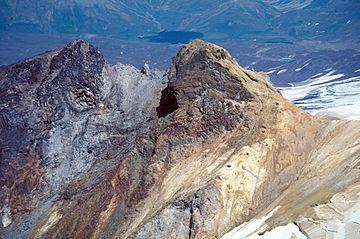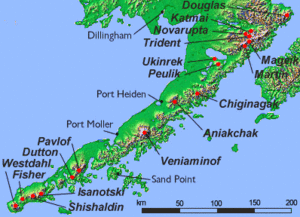Alagogshak facts for kids
Quick facts for kids Alagogshak |
|
|---|---|

Alagogshak summit in 1997
|
|
| Highest point | |
| Elevation | 5,495 ft (1,675 m) |
| Geography | |
| Location | Katmai National Park and Preserve, Alaska, U.S. |
| Parent range | Aleutian Range |
| Topo map | USGS Adak C-2 |
| Geology | |
| Mountain type | Stratovolcano |
| Volcanic arc/belt | Aleutian Arc |
Alagogshak is a large, inactive stratovolcano located in Alaska, United States. It stands within the beautiful Katmai National Park and Preserve. This volcano is a very old part of the Aleutian Range. It is also the oldest volcano near the famous Valley of Ten Thousand Smokes.
Contents
About Alagogshak Volcano
Alagogshak is a type of volcano called a stratovolcano. This means it is a tall, cone-shaped mountain built up by many layers of hardened lava, ash, and rocks. It is found on the Alaska Peninsula.
Location and Discovery
Alagogshak is located in a protected area called Katmai National Park and Preserve. This park is known for its stunning natural beauty and many volcanoes. Scientists officially recognized Alagogshak as its own separate volcano in 1997. Before that, it was sometimes confused with a nearby volcano called Mount Martin.
A Very Old Volcano
Alagogshak is the oldest volcano in its area. It was active a very long time ago, during the Pleistocene epoch. This period lasted from about 2.6 million years ago to 11,700 years ago. Alagogshak was erupting between 680,000 and 43,000 years ago.
Today, Alagogshak is no longer active. Its top, or summit, has a crater that shows signs of being changed by hot water. This means hot water moved through the rocks there a long time ago. Alagogshak is the only volcano in its group that is completely inactive now.
Relationship with Mount Martin
Mount Martin is another volcano located about 3 kilometers (2 miles) northeast of Alagogshak. Mount Martin is much younger. It actually sits partly on top of Alagogshak's very old and worn-down structure. This shows how new volcanoes can form near or even on top of older ones.
See Also


